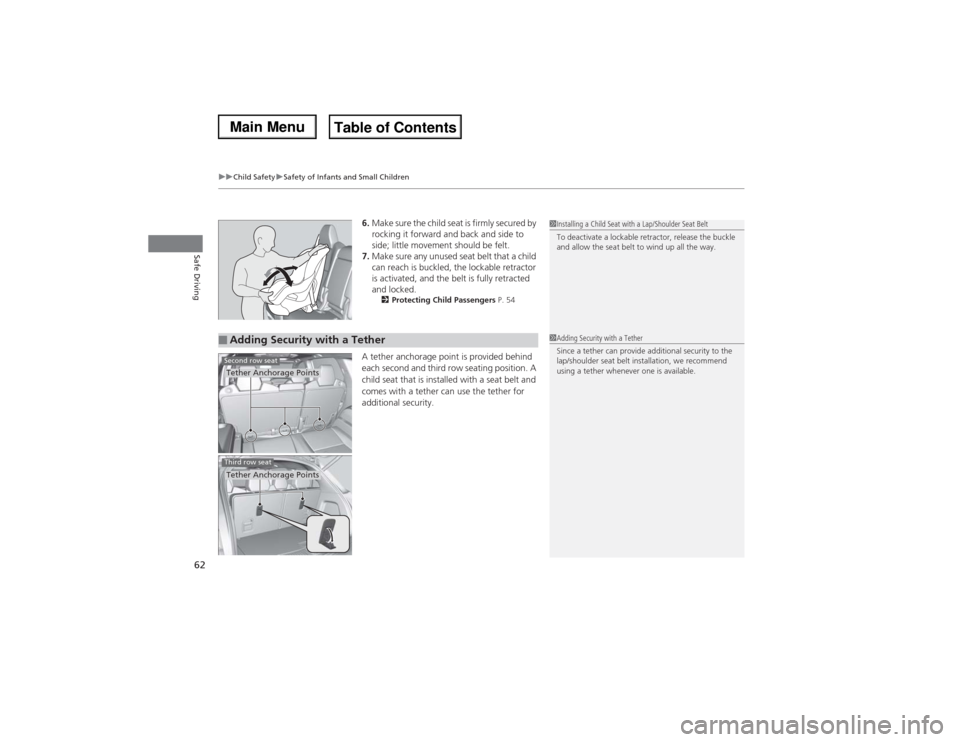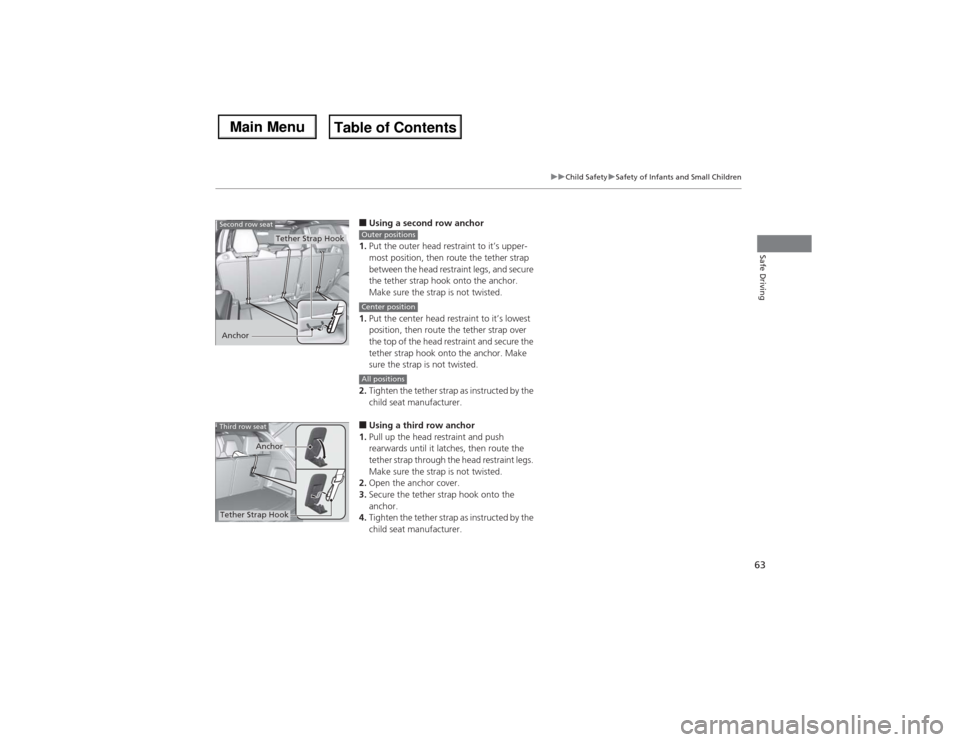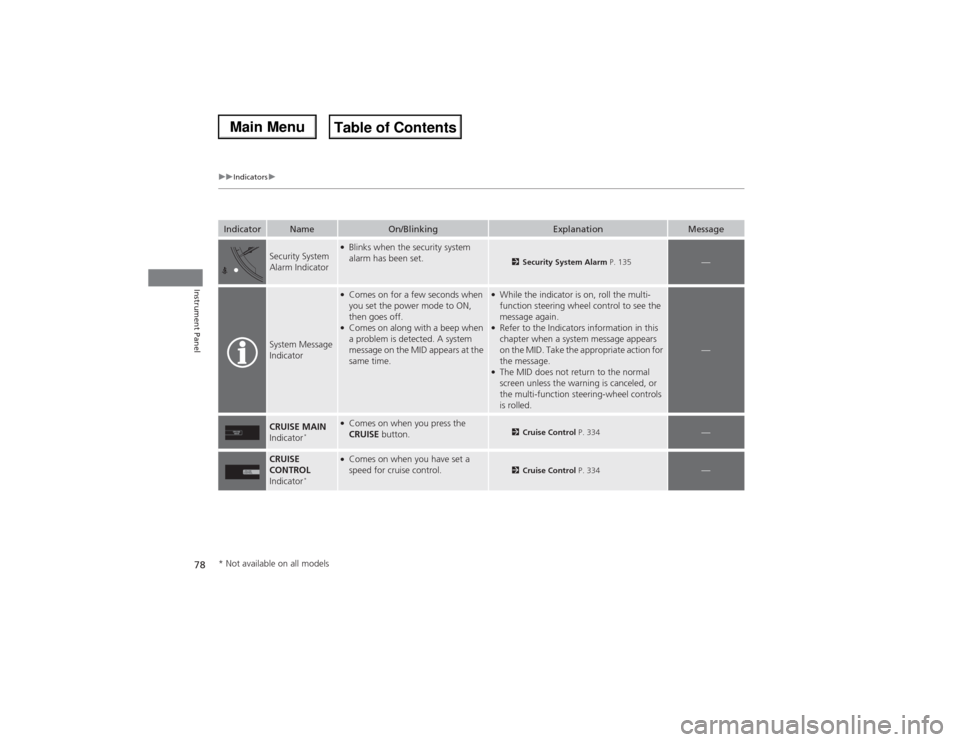ECU Acura MDX 2014 User Guide
[x] Cancel search | Manufacturer: ACURA, Model Year: 2014, Model line: MDX, Model: Acura MDX 2014Pages: 500, PDF Size: 11.72 MB
Page 61 of 500

uuChild SafetyuSafety of Infants and Small Children
60Safe Driving
3.Put the outer head restraint to it’s upper-
most position, then route the tether strap
between the head restraint legs, and secure
the tether strap hook onto the anchor.
Make sure the strap is not twisted.
3.Put the center head restraint to it’s lowest
position, then route the tether strap over
the top of the head restraint and secure the
tether strap hook onto the anchor. Make
sure the strap is not twisted.
4.Tighten the tether strap as instructed by the
child seat manufacturer.
5.Make sure the child seat is firmly secured by
rocking it forward and back and side to
side; little movement should be felt.
6.Make sure any unused seat belt that a child
can reach is buckled, the lockable retractor
is activated, and the belt is fully retracted
and locked.
2Protecting Child Passengers P. 54
Flexible Type
Outer positions
1Installing a LATCH-Compatible Child Seat
For your child’s safety, when using a child seat
installed using the LATCH system, make sure that the
child seat is properly secured to the vehicle. A child
seat that is not properly secured will not adequately
protect a child in a crash and may cause injury to the
child or other vehicle occupants.
Tether Strap Hook
Anchor
Center positionAll positions
Page 62 of 500

Continued
61
uuChild SafetyuSafety of Infants and Small Children
Safe Driving
1.Place the child seat on the vehicle seat.
2.Route the seat belt through the child seat
according to the seat maker’s instructions,
and insert the latch plate into the buckle.
uInsert the latch plate fully until it clicks.
3.Slowly pull the shoulder part of the belt all
the way out until it stops. This activates the
lockable retractor.
4.Let the seat belt completely wind up into
the retractor, then try to pull it out to make
sure the retractor is locked.
uIf you are able to pull the shoulder belt
out, the lockable retractor is not
activated. Pull the seat belt all the way
out, and repeat steps 3 – 4.
5.Grab the shoulder part of the seat belt near
the buckle, and pull up to remove any slack
from the lap part of the belt.
uWhen doing this, place your weight on
the child seat and push it into the vehicle
seat.
■Installing a Child Seat with a Lap/Shoulder Seat Belt
1Installing a Child Seat with a Lap/Shoulder Seat Belt
A child seat that is not properly secured will not
adequately protect a child in a crash and may cause
injury to the child or other vehicle occupants.
Page 63 of 500

uuChild SafetyuSafety of Infants and Small Children
62Safe Driving
6.Make sure the child seat is firmly secured by
rocking it forward and back and side to
side; little movement should be felt.
7.Make sure any unused seat belt that a child
can reach is buckled, the lockable retractor
is activated, and the belt is fully retracted
and locked.
2Protecting Child Passengers P. 54
A tether anchorage point is provided behind
each second and third row seating position. A
child seat that is installed with a seat belt and
comes with a tether can use the tether for
additional security.
1Installing a Child Seat with a Lap/Shoulder Seat Belt
To deactivate a lockable retractor, release the buckle
and allow the seat belt to wind up all the way.
■Adding Security with a TetherTether Anchorage PointsSecond row seat
1Adding Security with a Tether
Since a tether can provide additional security to the
lap/shoulder seat belt installation, we recommend
using a tether whenever one is available.
Tether Anchorage PointsThird row seat
Page 64 of 500

63
uuChild SafetyuSafety of Infants and Small Children
Safe Driving
■Using a second row anchor
1.Put the outer head restraint to it’s upper-
most position, then route the tether strap
between the head restraint legs, and secure
the tether strap hook onto the anchor.
Make sure the strap is not twisted.
1.Put the center head restraint to it’s lowest
position, then route the tether strap over
the top of the head restraint and secure the
tether strap hook onto the anchor. Make
sure the strap is not twisted.
2.Tighten the tether strap as instructed by the
child seat manufacturer.■Using a third row anchor
1.Pull up the head restraint and push
rearwards until it latches, then route the
tether strap through the head restraint legs.
Make sure the strap is not twisted.
2.Open the anchor cover.
3.Secure the tether strap hook onto the
anchor.
4.Tighten the tether strap as instructed by the
child seat manufacturer.
AnchorSecond row seat
Tether Strap Hook
Outer positionsCenter positionAll positions
Tether Strap Hook
Anchor
Third row seat
Page 65 of 500

64
uuChild SafetyuSafety of Larger Children
Safe Driving
Safety of Larger ChildrenThe following pages give instructions on how to check proper seat belt fit, what kind
of booster seat to use if one is needed, and important precautions for a child who
must sit in front.
When a child is too big for a child seat, secure the child in a rear seat using the lap/
shoulder seat belt. Have the child sit upright and all the way back, then answer the
following questions.
■Checklist
•Do the child’s knees bend comfortably over
the edge of the seat?
•Does the shoulder belt cross between the
child’s neck and arm?
•Is the lap part of the seat belt as low as
possible, touching the child’s thighs?
•Will the child be able to stay seated like this
for the whole trip?
If you answer yes to all these questions, the child is ready to wear the lap/shoulder
seat belt correctly. If you answer no to any question, the child needs to ride on a
booster seat until the seat belt fits properly without a booster seat.
■Protecting Larger Children■Checking Seat Belt Fit
1Safety of Larger Children
3
WARNING
Allowing a child age 12 or under to sit in
front can result in injury or death if the
passenger’s front airbag inflates.
If a larger child must ride in front, move the
vehicle seat as far to the rear as possible,
have the child sit up properly and wear the
seat belt properly, using a booster seat if
needed.
Page 66 of 500

65
uuChild SafetyuSafety of Larger Children
Safe Driving
If a lap/shoulder seat belt cannot be used
properly, position the child in a booster seat in
a rear seating position. For the child’s safety,
check that the child meets the booster seat
manufacturer’s recommendations.
Your vehicle has a rear seat where children can be properly restrained. If you ever
have to carry a group of children, and a child must ride in front:
•Make sure you read and fully understand the instructions and safety information
in this manual.
•Move the front passenger seat as far back as possible.
•Have the child sit upright and well back in the seat.
•Check that the seat belt is properly positioned so that the child is secure in the
seat.
■Monitoring child passengers
We strongly recommend that you keep an eye on child passengers. Even older, more
mature children sometimes need to be reminded to fasten their seat belts and sit up
properly.■Booster Seats
1Booster Seats
When installing a booster seat, make sure to read the
instructions that came with it, and install the seat
accordingly.
There are high- and low-type booster seats. Choose a
booster seat that allows the child to wear the seat
belt correctly.
Some U.S. states, and Canadian provinces and
territories require children to use a booster seat until
they reach a given age or weight (e.g. six years or 60
lbs). Be sure to check current laws in the state or
province, or territory where you intend to drive.
■Protecting Larger Children-Final Checks
Page 79 of 500

78
uuIndicatorsu
Instrument Panel
Indicator
Name
On/Blinking
Explanation
Message
Security System
Alarm Indicator
●Blinks when the security system
alarm has been set.
2Security System Alarm P. 135
—
System Message
Indicator
●Comes on for a few seconds when
you set the power mode to ON,
then goes off.●Comes on along with a beep when
a problem is detected. A system
message on the MID appears at the
same time.
●While the indicator is on, roll the multi-
function steering wheel control to see the
message again.●Refer to the Indicators information in this
chapter when a system message appears
on the MID. Take the appropriate action for
the message.●The MID does not return to the normal
screen unless the warning is canceled, or
the multi-function steering-wheel controls
is rolled.
—
CRUISE MAIN
Indicator
*
●Comes on when you press the
CRUISE button.
2Cruise Control P. 334
—
CRUISE
CONTROL
Indicator
*
●Comes on when you have set a
speed for cruise control.
2Cruise Control P. 334
—
* Not available on all models
Page 107 of 500

106
uuGauges and Multi-Information Display (MID)uMID
Instrument Panel
Exit
Door SetupIDS SetupDefault AllLighting Setup
Key And Remote Unlock Mode
Auto Door LockAuto Door Unlock
Keyless Lock Answer BackSecurity Relock Timer
Interior Light Dimming Time
Headlight Auto Off TimerAuto Light Sensitivity
Roll
PushPush
RollRollRollRoll
Roll
Roll
Power Tailgate Setup
Push
Power Open By Outer Handle
Keyless Open Mode
Push
Maintenance Info.
Roll
Push
Preferred IDS Mode
RollRollRoll
Page 110 of 500

109
uuGauges and Multi-Information Display (MID)uMID
Continued
Instrument Panel
*1: Default SettingSetup Group Customizable Features Description Selectable SettingsLighting
Setup
Interior Light Dimming
Time
Changes the length of time the interior lights stay on
after you close the doors.
60sec/30sec
*1/15sec
Headlight Auto Off
Timer
Changes the length of time the exterior lights stay
on after you close the driver’s door.
60sec/30sec/15sec
*1/0sec
Auto Light Sensitivity
Changes the timing for the headlights to come on.
Max/High/Mid
*1/Low/Min
Door SetupAuto Door LockChanges the setting for the automatic locking
feature.With Vehicle Speed
*1/Shift
From P/Off
Auto Door UnlockChanges the setting for when the doors unlock
automatically.All Doors When Driver’s
Door Opens
*1/All Doors
When Shifted To Park/All
Doors When Ignition
Switched Off/Off
Key And Remote Unlock
ModeSets up either the driver’s door or all doors to unlock
on the first operation of the remote or built-in key.Driver Door*1/All Doors
Keyless Lock Answer
BackLOCK/UNLOCK- The exterior lights flash.
LOCK (2nd push)- The beeper sounds.On
*1/Off
Security Relock TimerChanges the time it takes for the doors to relock and
the security system to set after you unlock the
vehicle without opening any door.90sec/60sec/30sec
*1
Page 114 of 500

113
Controls
This chapter explains how to operate the various controls necessary for driving.
Clock.................................................. 114
Locking and Unlocking the Doors
Key Types and Functions .................. 115
Locking/Unlocking the Doors from the
Outside .......................................... 117
Low Keyless Access Remote Signal
Strength......................................... 123
Locking/Unlocking the Doors from the
Inside ............................................. 124
Childproof Door Locks ..................... 126
Auto Door Locking/Unlocking .......... 127
Opening and Closing the Tailgate... 128
Security System
Immobilizer System .......................... 135Security System Alarm...................... 135
Opening and Closing the Windows... 138
Opening and Closing the Moonroof
.. 140
Operating the Switches Around the
Steering Wheel
ENGINE START/STOP Button............. 141
Turn Signals ..................................... 144
Light Switches.................................. 145
Daytime Running Lights ................... 148
Wipers and Washers ........................ 149
Brightness Control ........................... 153
Defogger/Heated Door Mirror .......... 154
Driving Position Memory System ...... 155
Adjusting the Steering Wheel........... 157Adjusting the Mirrors
Interior Rearview Mirror ................... 158
Power Door Mirrors ......................... 159
Adjusting the Seats
Adjusting the Seat Positions ............. 161
Rear Seats........................................ 168
Armrest ........................................... 171
Interior Lights/Interior Convenience Items
Interior Lights .................................. 172
Interior Convenience Items .............. 174
Climate Control System
Using Automatic Climate Control .... 185
Rear Climate Control System ........... 192
Automatic Climate Control Sensors ... 196